The Yarwhosians?
You may not have heard of them, but the civilized Neolithic Yarmukians created some of the world’s earliest clay sculptures.
016
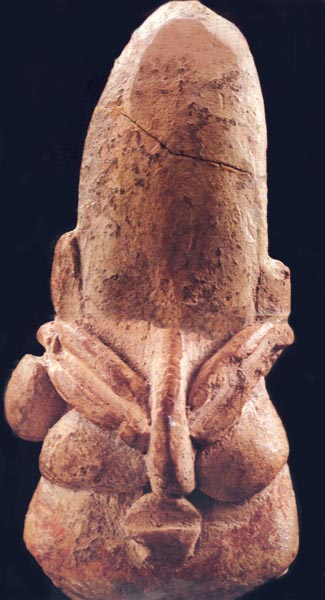
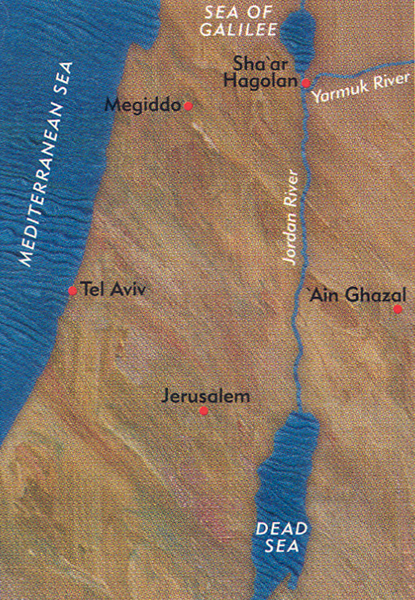
017
Prepare to fall in love—with our friends the Yarmukians. Since they lived almost 8,000 years ago, about 3,000 years before people began communicating in writing, you can’t ask them who they were. And even if you could, it’s doubtful you would understand their answer; we don’t even know what language they spoke. But we don’t need to speak to the Yarmukians to know something about their intricate and interesting lives. We only have to look at the material they left behind—the buildings they lived and worked in, the tools they used to produce and cook their food, the objects they traded with others, and the items they used to adorn themselves and their homes. We also have 018objects that today we’d call “art”; expressions of their humanity and perhaps even of the belief in something beyond the human.
One of us (Yosef) has lived with Yarmukians for over a decade now; together we’ve spent innumerable hours studying their material remains, thinking about their lives, even dreaming about them. The more we get to know about them, the more we see how much we have yet to learn. We visit the Yarmukians every year at our site, Sha‘ar Hagolan (the Gate to the Golan). It lies in the fertile Jordan Valley, about two miles south of the Sea of Galilee, on the bank of the Yarmuk River—which explains the name we have given them.
The site was discovered by members of Kibbutz Sha‘ar Hagolan, when they were constructing fishponds in the late 1930s. For 60 years, school kids and their families have been walking the fields of the kibbutz during afternoon leisure hours and on weekends searching for antiquities.
Between 1949 and 1952 Hebrew University archaeologist Professor Moshe Stekelis dug at the site. Recognizing the unique nature of the ancient material culture, Stekelis designated it “Yarmukian.” The kibbutz’s residents were also aware of the importance of what had been found: In 1952 they opened an exhibit of their antiquities collection in a bomb shelter. This became Israel’s first museum of prehistory. This early museum is mentioned by the anthropologist Robert Ardrey in his pathbreaking book The Territorial Imperative (1966):
You may visit a kibbutz called Sha‘ar Hagolan, near the Sea of Galilee and within gunshot of the Jordan border. You may inspect the Neolithic antiquities which in their spare time the members have dug from their fields and which they display in a convenient bomb shelter; and you will have no need to examine the beaver to confirm the enhancement of energy in a territorial defender.
In the 1970s the kibbutz put up a new larger building to house the collection.
In 1989 we began to investigate the site, 37 years after Stekelis completed his excavations. A few years later, the fishponds went out of service and a nearby olive grove was uprooted; thus, for the first time, it was possible to undertake a large-scale excavation. In 1999 we completed our sixth year of this projected 10-year expedition, but we have found enough exciting new material to justify this preliminary report.
One of our most culturally and sociologically important discoveries is that Sha‘ar Hagolan was a permanent settlement with stone houses, paved streets and even alleys. At Sha‘ar Hagolan we can witness a major historical change in social organization: A culture based on small nomadic bands of hunters and gatherers was being replaced by a new lifestyle in which people lived in permanent villages based on an agricultural economy. This universal process seems to have first occurred here in the Jordan Valley; then it spread to other parts of the Near East.
This view of Sha‘ar Hagolan is quite different from earlier understandings. Stekelis excavated a large number of pits but found no permanent architecture. From this he concluded that “the Neolithic settlers of Sha‘ar Hagolan apparently lived in circular huts, half sunk below ground level.” This conclusion was buttressed by the fact that rounded pits, without solid architecture, have been reported from other sites with Yarmukian pottery. These pits created the false impression that the Yarmukians were seminomadic and pastoral, inhabiting the sites only part of the year.1
In our excavations we have uncovered three monumental building complexes with 019rectangular rooms. Between the structures were streets from which one entered the courtyards of the buildings. Small roofed rooms surrounded the courtyard and opened onto it. These complexes are the earliest examples in Israel of the so-called courtyard building, which later became very common in the ancient Near East and persists to this day in traditional village communities.
These building complexes are quite large: One is 3,600 square feet; another complex, which we have been excavating for ten years, is at least twice as large. The buildings’ walls were made of stone or mudbrick. Most walls consisted of a combination of stone and mudbrick—with the bottom layers (or socle) made of stone and the upper layers made of mudbrick. The mudbricks are unusual—circular, flat on the base and rounded on the top, like a round loaf of bread. Some of the rooms were paved with flat basalt river pebbles.
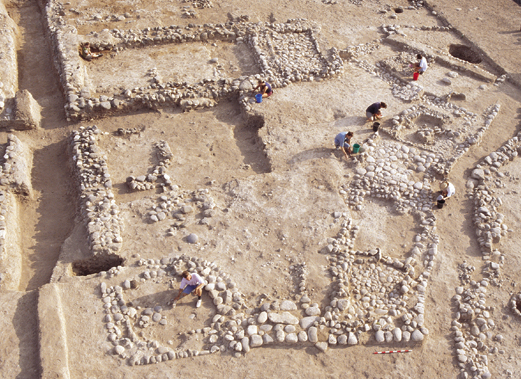
The street we uncovered was straight, about 10 feet wide and paved with small river pebbles and mud plaster. We have exposed over 100 feet of this street. A smaller alley, which we have exposed to a length of 50 feet, is curved and is only about 3 feet wide.
Although only a small part of the site has been excavated, various survey techniques have enabled us to estimate the entire area of land that was occupied during the Yarmukian period. An intensive field survey lead by Michele—in which teams of archaeologists walked in equal-sized “transects” of land, picking up every piece of cultural material they found on the ground—enabled us to determine where the Yarmukians lived and where they did not. A magnetometer survey, conducted by Sonya Itkis, permitted us to detect walls beneath the ground surface in some of these areas. We estimate that the ancient town covered nearly 50 acres, 020making Sha‘ar Hagolan one of the largest Neolithic settlements in the Near East.
The abundance of finds gives us an intimate glimpse of daily life in ancient Sha‘ar Hagolan, where we estimate about 3,000 people once lived. As usual in an excavation in the ancient Near East, pottery was very common. But here the appearance of pottery has a special significance. The Neolithic era is subdivided into four periods, as shown in the sidebar to this article. The first three periods are designated Pre-Pottery periods. Pottery was first introduced toward the end of the Neolithic era, in the middle of the seventh millennium B.C.; this is the period represented at Sha‘ar Hagolan. The pottery we uncovered here—all handmade, rather than wheel-made—is the earliest ever discovered in Israel. It represents a technological innovation of the greatest importance.

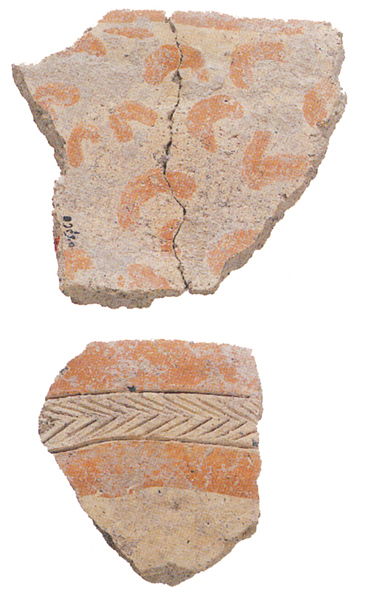
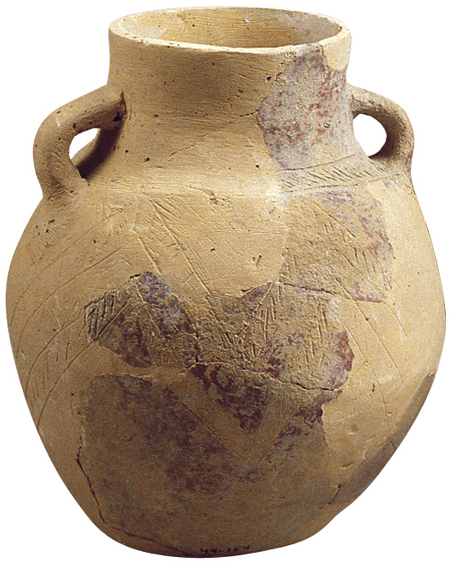
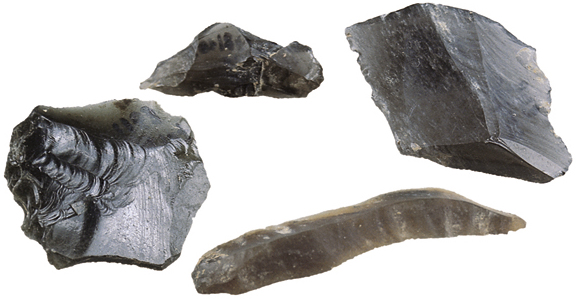
Surprisingly, Yarmukian pottery includes not only coarse undecorated vessels with thick walls and rough surfaces, but also fine vessels with smooth surfaces and elaborate decoration. The coarser ware was probably used for storing grain and liquids, as well as for cooking.
The finer ware was incised and painted. The paint is always a shade of red and either covers the whole vessel or follows the incised lines. The incisions include horizontal lines, zigzag lines and herringbone patterns. The decorated pottery was probably used for serving food.
A large assemblage of bi-conical clay spindle whorls provides evidence of textile manufacture. The garments themselves, however, would have disintegrated long ago in this moist climate.
The only thing more common than pottery at Sha‘ar Hagolan is flint—the most characteristic material found at prehistoric sites in the Near East. Over the years, by sieving all the sediment from the excavation, we have recovered hundreds of thousands of flint flakes, though only a small number are tools produced for specific tasks. Most of the flint is waste from flint knapping (the chipping away of flint flakes in making tools or weapons).
The three most prevalent flint artifacts at Sha‘ar Hagolan are arrowheads, sickle blades and axes. The arrowheads represent a triumph of flint technology. About an inch long with symmetrical aerodynamic points, they were fastened to the tip of an arrow shaft and shot with a bow.
The sickle blades and axes are characteristic of the period. The former have coarse denticulation (toothlike projections) on the working edges, commonly fashioned by knapping the flint on both sides. The axes are of two types: broad and narrow.
Other tools were also made of stone, either hard volcanic basalt or limestone. Both were locally available. Some were used by ancient Yarmukian cooks to prepare food—either as mortars and pestles or as grindstones. The cook would slide the grinding stone back and forth across the surface of a stone slab, pulverizing the grain. Some of the stone implements, heavy stone bowls, seem reminiscent of an earlier time when pottery bowls were 021not available. And we even found a rare spoon made of limestone. Clay spoons are well known, but this is the only extant example in stone.
We also found a large variety of stone weights. Most had a hole drilled through the center or near the edge. Those without holes usually had a notch at the center, allowing a string to be securely tied around the weight. The largest weights were probably boat anchors. The smaller ones look like fishing weights, evidence of marine activity both in the Yarmuk River and the Sea of Galilee.
Many articles of daily life did not survive, such as wooden objects and baskets. Yet we can still see the impression of some straw mats on the bases of pottery; the pottery was either fashioned on the mats or set upon them to dry.
Some of the rarer objects are especially interesting because they provide evidence of extensive trade routes and lively commercial activity. Various types of seashells—cowries, columbellas and cockles—came from the Mediterranean Sea, nearly 40 miles west of Sha‘ar Hagolan. About ten obsidian artifacts, including one arrowhead, were found in the buildings. They are tiny but of fine quality—gray, translucent and very sharp. The nearest obsidian deposits are in Anatolia (and Armenia), about 450 miles north of Sha‘ar Hagolan.
Previous excavation reports on Yarmukian sites make no mention of either seashells or obsidian. As a result of our finds, however, we now know that the Yarmukian people did not live in isolation but maintained contact with neighboring regions.
Our most tantalizing find is a rich collection of anthropomorphic figurines. We have now recovered almost 200 of them, although many are mere fragments. A few of the figurines are zoomorphic rather than anthropomorphic.

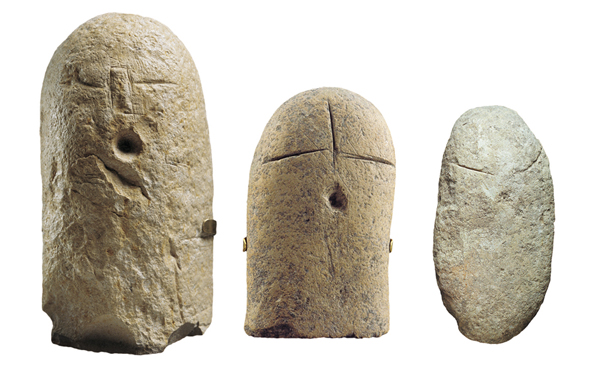
Why were they made? Who made them? Who used them? Do the anthropomorphic figures represent humans or divinities? What are the sources of the Yarmukian iconographic tradition? Why are there so many of these objects? Why have so many of them been discovered at one site, Sha‘ar Hagolan, and so few at other Yarmukian sites? The questions are many, the answers few.
The most common—and engaging—human figurines are seated clay figurines with cowrie-like eyes. We have five complete, or nearly complete, examples, along 023with 70 fragments of various body parts. Each body part was made separately—head, torso, right leg, left leg. The components were assembled to create the basic figurine. Then small details were added: Eyes, ears and nose were put on the head; a veil was placed over the nape of the neck; arms, breasts and clothing were added to the body; fingers and fat folds were created by using different incision techniques; and the navel was depicted by a puncture mark. Remaining patches of paint on the figurines indicate that sometimes the entire figurine was painted red, while at other times only specific parts of the body were painted with red lines. The use of the color red—which is often associated with blood, and thus with life and fecundity—on these figures is intriguing.
With one exception, all the anthropomorphic figurines represent women. All also share certain aesthetic qualities. Most notably, the head is elongated—to suggest, we believe, a tall hat, since the hair is modeled at the back of the head but not at the top. The eyes, too, are elongated, set diagonally and created by sticking clay lumps on the face and incising them lengthwise with a deep slit. To some viewers, the eyes resemble coffee beans, while others believe they mimic cereal grains, such as wheat. The evidence, however, suggests that they were meant to imitate cowrie shells. Due to their resemblance to female genitalia, cowrie shells have been considered fertility symbols in many societies around the world.
On some of the figurines we can also see earrings, made of rounded lumps of clay appended to the ear. This is the earliest evidence of the use of earrings in the ancient Near East.
The figures are clothed in such a way that part of the abdomen and the navel are exposed. The breasts, too, are often exposed, but they are small and not emphasized (this is in stark contrast to other Neolithic figurines, in which the breasts are exaggerated). It appears that the clothing consists of two overlapping capes, possibly made of animal skins. On a couple of figurines, we see a scarf consisting of a horizontal clay ribbon circling 024the area of the throat. The pelvis is the most heavily emphasized part of the figurine and marks its maximal circumference. The enlarged pelvis may represent an excessive development of fat on the buttocks known as steatopygia, which is in fact common among some peoples around the world. The female sex organ is not indicated in these figurines. The male sex organ is present in one example.
How were these figurines used? Probably for some cultic function. Were they fertility talismans, made to assure the fruitfulness of flocks and fields? Did they represent some sort of deity to be worshiped, perhaps a mother goddess? Or were they representations of beloved ancestors, used in an ancestor cult? No one knows. What we can say is that they appeal to our modern aesthetic sense.
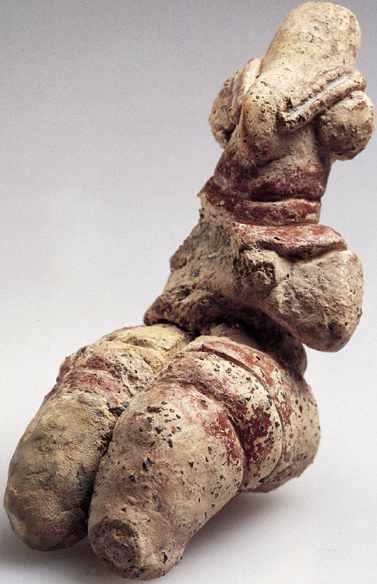
Parts of a larger clay statues were also recovered, from which the missing parts could be plausibly reconstructed. Like the figurines just described, it is seated. The half life-size head, one leg and a few fragments were found intentionally buried in a very shallow pit, perhaps as part of a cultic ritual. Although in several respects this larger statue resembles the seated figurines with cowrie-like eyes (such as in its greatly elongated head), in other respects it is distinctive: The facial features are barely outlined, for example, and the nose was made simply by pinching and shaping the clay.
Two other types of figurines complete the repertoire from Sha‘ar Hagolan: four pillar figurines (so named because the artist concentrated on facial features, omitting body parts) and 105 pebble figurines.
By engraving the oblong river pebbles with just a few lines, the ancient artists depeicted a whole range of human characteristics. They vary considerably in size, from a mere ounce to over 13 pounds, although most weigh about a pound. Traces of red pigment on some of the figurines may indicate that they were also painted, but now we have only these spare carvings to indicate their features. Some show details of body and dress while others show only a face. And still other only have eyes.
Do these motifs have some special symbolic significance? Many of the same features appear on these pebbles as on the clay figurines, such as oblique eyes, heavy thighs and a symmetrical three-part garment. Clearly there is some relationship between the two figurine types, and we suggest they were meant to convey the 025same symbolic message, although what exactly that was, we may never know.
While the figurines cannot tell us much about Neolithic religion, it appears they were used by individual households . Only the large clay statue and the largest pebble figurine suggest a communal aspect.
While Yarmukian culture is known at 20 other sites on both sides of the Jordan and in Lebanon,2 none of the other sites appears to be as large as Sha‘ar Hagolan, which may have been a center for the entire Yarmukian people and the home of the Yarmukian elite.
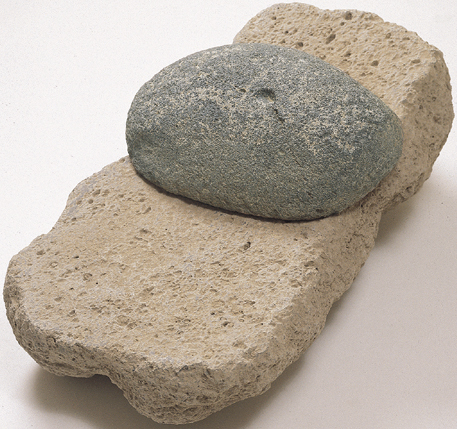

For so far it appears that only at Sha‘ar Haglolan did the Yarmukians build large structures, separated by streets and alleys. And it is here they lived in great numbers, and here that trade routes came together. And it is at this site we find so many of the arresting little sculptures that perhaps show us the Yarmukians as they saw themselves.
The excavations at Sha‘ar Hagolan are being conducted on behalf of the Institute of Archaeology of the Hebrew University of Jerusalem with grants from the Curtiss T. and Mary G. Brennan Foundation and the Philip and Muriel Berman Center for Biblical Archaeology.
Prepare to fall in love—with our friends the Yarmukians. Since they lived almost 8,000 years ago, about 3,000 years before people began communicating in writing, you can’t ask them who they were. And even if you could, it’s doubtful you would understand their answer; we don’t even know what language they spoke. But we don’t need to speak to the Yarmukians to know something about their intricate and interesting lives. We only have to look at the material they left behind—the buildings they lived and worked in, the tools they used to produce and cook their food, the […]
You have already read your free article for this month. Please join the BAS Library or become an All Access member of BAS to gain full access to this article and so much more.
Already a library member? Log in here.
Institution user? Log in with your IP address or Username
Endnotes
In a recently published book on urban development from late prehistory until the First Temple period, Ze’ev Herzog describes the Yarmukian era as “a major breakdown … The collapse is evident from the disintegration of all major settlements and the erection of small villages. The dominant dwelling form in this period is the circular house; in most cases these were only circular pits that formed the lower part of huts” (Ze’ev Herzog, Archaeology of the City [Tel Aviv: Tel Aviv University, Institute of Archaeology, 1997], p. 27).
